Buffalo are social creatures. They like living together in herds.
But not just any herd. Their own herd. The one in which they know everyone else intimately. Usually they are relatives.
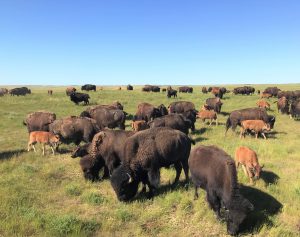
Cows with young calves, still red-gold hair. Buffalo like living in herds of animals that they know. Photo by F.Berg
And not too large a herd—30 to 60 seems a good size.
Except sometimes it’s the “bigger the better.” That happens in late July and August when historically the great herds came together for breeding season.
Professor Dale F. Lott writes that the relationships between bulls and cows become especially intense at that time. But that, however, the intensity is shifting and short-lived.
In his book American Bison: A Natural History, he describes the buffalo’s social behavior as “too marvelous a tale to go untold. The most complex relationships play out.”
It’s true. Who knew those sometimes sleepy-looking animals have such complexity and intensity in their relationships?
Maternal Herds—an older Grandmother Leads
For most of the year, the buffalo sort themselves into “cow groups” or maternal herds and “bull groups.”
The Vasquez de Coronado expedition exploring Texas in 1543 reported their surprise in seeing “innumerable herds of bulls without a single cow, and other herds of cows without bulls.” Kansas Historical Society.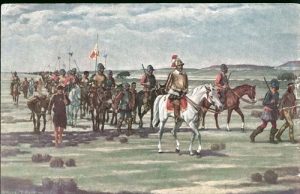
The Spanish explorer Francisco Vasquez de Coronado travelled across the southwest as far north as Kansas following buffalo and Indian trails searching for gold. His great expedition of 300 soldiers and some 1,000 Indians often shot buffalo for food, but found no riches.
A soldier along on the expedition wrote of the buffalo they encountered in Texas in 1543, “We were much surprised at sometimes meeting innumerable herds of bulls without a single cow—and other herds of cows without bulls.”
Maternal herds include buffalo cows and calves and young bulls up to 2 or 3 years of age.
Cows and calves and young bulls live together in maternal herds. NPS.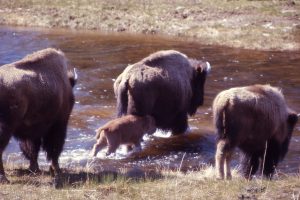
An older grandmother is the usual leader of the herd. She leads them to water at the time that seems right to her.
When she bosses the others around and disciplines those who need it, that’s considered okay. It’s her job. They give her due respect, knowing she’s earned it.
Then there are the simpler, more lasting relationships between cows in a herd. Often they are related to each other. Mothers and sisters and aunts.
When they need help, a sister might come to help.
Cows are fiercely protective of their caves—and calves have a special relationship with their mothers. But once separated, that bond may be broken and the mother not return to her calf.
Mothers fiercely protect their calves. Photo by Chris Hull, SD Game, Fish and Parks.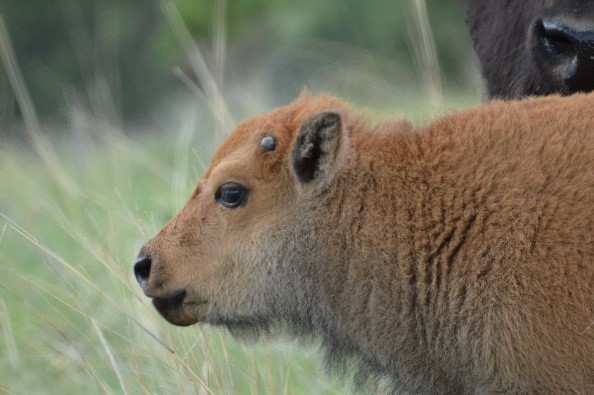
Heifer calves stay long-term with their mother’s herd.
Bachelor Herds of Young Bulls
Bull calves are only allowed to stay in the herd with their mothers until they become too large and aggressive.
Then they are kicked out of the maternal herd to join bachelor groups that wander at some distance from the main herd.
In the wild herds of long ago, with roughly equal numbers of males and females, bachelor herds were known to be large.
Today in managed herds, young bulls are usually sold off long before they reach age three. They sell well in the market place, either as potential herd bulls or when slaughtered for meat.
In Indian tribal herds young bulls are especially desirable to provide meat for naming feasts and community gatherings. By giving of their meat, they honor the person celebrated, especially when the honored one is a young man.
Young bulls are usually sold to avoid over-grazing of pastures.
This prevents buffalo herds from out-growing their land base. Otherwise the herd will double and redouble in a few years, soon over-grazing their pastures.
Having fewer bulls means less fighting, and makes breeding easier for the dominant bulls.
Older bulls wander farther away from herd, sometimes in tandem with another old bull. Photo by Vince Gunn.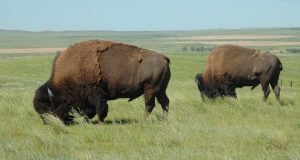
The oldest bulls likely wander farther away. Maybe they lost too many battles and were chased way by dominant bulls.
Sometimes a lone older bull moves in tandem with another old bull, staying a quarter mile or so distant from each other. Other times each may be totally alone.
An older bull often ranges far from his home herd. Yellowstone Park, NPS.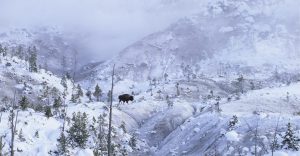
Noble fathers Defend
For most of the year, except during breeding season, the big bulls are often found at some distance from the herd. Nevertheless, they stay watchful.
Buffalo bulls are born with a strong sense of responsibility.
They keep an eye on predators—such as the wolf packs of former days that followed the herds.
Lewis and Clark wrote about the buffalo herds “and their shepherds, the wolves.” While the wolves did not usually attack healthy buffalo, they often killed a lone injured buffalo hanging off to the side.
The bulls paid little attention to the wolves unless they were threatening the herd.
Then the “noble fathers,” as they’ve been called, moved quickly to protect mothers and calves.
I saw those “noble fathers” in action once myself. Our kids were teenagers then and with friends, we were riding horseback in the North Unit of Teddy Roosevelt Park.
We were about 15 riders, talking and laughing—so we probably looked like trouble as we came trotting over a hill.
There below us in a broad valley, a herd of about 60 buffalo were spread out grazing. They looked up and started to run, alarmed by our sudden appearance.
We pulled in our horses and paused to watch.
They didn’t run far. The big bulls stopped in an open area and formed a tight circle facing us, shaking their massive heads. Cows and calves took to the inside behind them.
Here’s how Colonel R.I. Dodge, described the behavior of bulls reacting like this in his 19th century book, Plains of the Great West.
“The bulls with heads erect, tails cocked in air, nostrils expanded and eyes that seem to flash fire, walk uneasily to and fro, menacing the intruder by pawing the earth and tossing their huge heads.”
Our modern-day buffalo bulls reacted in just that way—flashing fire, pawing the earth, shaking their heads in fury. Plainly, they were in a defensive mode that they all understood—the bulls ready and eager to take us on. The calves well-hidden and protected.
We understood them, too. It was clear they intended to fight if needed.
As we paused to watch, we were delighted to think that—for over 100 years, this very herd had lived safely inside a national park, without any large enemies to fear. No wolves nor grizzly bears nor hunters.
Yet these “noble fathers” stood ready to fight us off and protect with their lives the young calves and their mothers, just as their ancestors did long ago when real enemies threatened. No hungry wolves would have broken through their defenses that day!
We skirted far around and let the bulls think they had stood off our attack.
In an unusual rescue of long ago, a Blackfeet Indian reported seeing a young buffalo bull charge a grizzly bear that had attacked a heifer.
The grizzly was lying in wait, hidden by a trail near a creek when a small bunch of buffalo trailed down to drink. Led by a young heifer, they walked down the bank in single file.
As the heifer passed under the clay shelf where the grizzly hid, he reached down with huge front paws and caught her around the neck, then leaped on her back.
With a loud snort, she struggled to escape.
Suddenly a “splendid young buffalo bull” came rushing down the trail and charged the bear, knocking him down.
They fought fiercely. The grizzly tried to grab the bull by the head and shoulders, but could not hold him.
The bull slashed furiously with his heavy horns.
Blood gushing from mortal wounds, the bear tried to escape, but the bull would not let him go. He kept up the attack until he had killed the bear.
Even then he continued to gore and toss the bear’s carcass off the ground. He seemed insane with rage.
The Blackfoot hunter—who was also hiding near the trail—was much afraid he’d be discovered and attacked too. Finally, to his relief, the bull dropped the carcass and went off to join his band.
Ernest Thompson Seton, a Canadian writer, reported in Lives of Game Animals that “when calving, a buffalo cow can fight off one or two wolves. But if more attack, she calls for help.
“Her loud angry snort will quickly bring the bulls to her aid.”
When hunting, Native hunters preferred to kill cows and young bulls, for better, more tender meat than they’d get from the tough older bulls. But first they had to get past the big bulls that protected the outside of the herd.
A white hunter who joined the annual Miami hunt in Kansas in August 1854 explained how the Miami Natives reached the animals they wanted.
Big bulls took to the outside of herd when attacked, protecting cows and calves in center. CM Russell.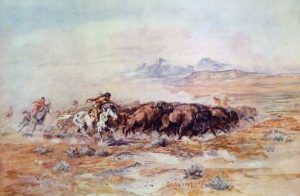
“They shoot down several bulls. As a gap in the line is thus made, they dash their ponies through the breach, conforming speed and direction to that of the herd.
“Gradually working toward the center, they find the cows, calves and two-year-olds, thus securing the finest robes and choicest meats.
“When their revolvers are empty, for only revolvers and bows and arrows can safely be used in this mode of killing, they worm their way out of the herd in the same manner as they entered.”
In blizzards and fierce storms, too, observers say, the large bulls form a triangle facing into the wind and shield cows and calves from wintery blasts.
Breeding Season: When big Herds Come Together
During rut, the late July and August breeding season, when large herds came together—and still do in places with large herds like Yellowstone Park—the buffalo relationships “embrace attraction, rejection, acceptance, competition and cooperation within and between the sexes,” according to Professor Lott.
At National Parks, larger herds come together during breeding season in late July and August. Badlands National Park, SD, photo by Stephen Pedersen.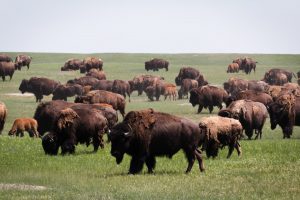
Lott writes that these relationships, though intense, are short-lived.
As young boy Lott grew up in sight of buffalo every day on the National Bison Range in Montana. He was born there in 1933—the same year as White Medicine, the most famous white buffalo of all time, who lived there all his 26 years.
He was very familiar with what he called the buffalos’ “social behavior, too marvelous a tale to go untold.”
Lott describes the chaos of breeding season. In rut, he says, the major dominant bull seeks out a cow that is nearly ready to breed, and “tends” her for a day or two, staying close and chasing other bulls away.
After she is bred, he finds another cow. If a rival bull is tending that cow, the dominant bull chases him off if he can, and takes over.
If he can’t, but persists, they fight until the battle is settled.
Two big bulls will fight furiously, slamming heads, battling for dominance. But most of their interactions are peaceful, as all know their rank order and tend to accept it.
The weaker, more submissive bulls give up easily and wander away. They know they can’t win—maybe they’ve battled that tough bull before.
The winner recognizes the other’s surrender and without wasting any more energy, lets him go.
Pecking order sets Buffalo Rules
Every buffalo knows where he or she stands in the herd’s ranking order. Each defers to those with higher ranking, and takes advantage of those with lower rank, pushing them away from what are deemed the tastiest grasses.
Each animal knows where he or she stands in the herd’s pecking order. Photo by Mana2580.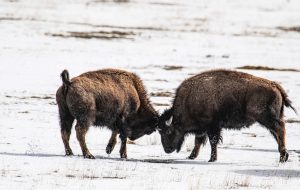
It’s called the “pecking order,” enforced by all. Each individual has a strong sense of where he or she stands in the herd, and accepts and respects that pecking order.
Regardless of how they are related, each of the females is in a dominant or submissive position to each of the others. A calf ranks with its mother.
In field research for his doctorate at the University of Wisconsin, Tom McHugh spent three months studying the ranking or “pecking” order of 16 buffalo in a Jackson Hole Wildlife Park near Yellowstone.
McHugh identified each buffalo, naming them by their horns (“Ring,” “Straight,” “Uneven”), their hides (“White Hump,” “Dark Hump,” “Scar”) or facial features (“Thin”). He got to know each individual and gave each a name and number—with a dab of paint when necessary, especially for the yearlings and 2-year-olds, which were harder to distinguish from each other.
When all were clearly identified and he could tell them apart, McHugh began charting their interactions.
Lacking sufficient grazing that winter, the buffalo were fed hay. As the hay wagon dropped its load each morning, the rankings were clearly revealed.
The main dominant bull strode to the first pile of hay, pushing all others away, shaking his head threateningly. The others moved off with scant protest to another pile—where they jostled the more submissive ones there.
Before long that first bull saw a newer, better pile of hay, and moved aggressively to claim it.
Three cows, already eating there stepped away quickly, jostling each other for position at the next best hay pile.
After a short time, the dominant bull moved on to a pile of hay he perceived as better, again chasing away subordinates. Usually he was treated respectfully—the more submissive ones simply moved away.
Big bulls eat their fill before allowing others to reach tasty hay. Photo by F Berg.
Typically, he ate there only a short time before moving again and displacing other buffalo—who displaced and jostled others and moved down one pile or more.
Meanwhile the 2nd and 3rd ranked animals moved up behind Number 1, displacing those of lower rank.
And so it went, from one pile to the next—the bigger, more aggressive buffalo displacing lower levels. However, they invariably showed submissive behavior to those of higher rank.
McHugh reported that Bull 6 dominated Bull 5, who dominated White Hump, who dominated Scar and all the way down the line to Yearling Heifer1B, the lowest-ranking animal of all.
Unfortunately for her, Yearling Heifer1B was subjected to head butts and horn prodding from all the other buffalo. She dared not retaliate against any of them.
Satisfied that he had discovered the truth of hierarchy for his book, “The Time of the Buffalo,” McHugh concluded: “Research showed that, far from being an arbitrary collection of similar animals, this society of buffalo was organized into a complex and discernible order of rank!”
McHugh also reported that rankings were disrupted with the birth of new calves, or when a new individual joined the herd, or young bulls began to assert themselves over previously dominant cows.
Rankings are disrupted when new individual joins the herd or young bulls begin to assert themselves. Photo by Richard Lee.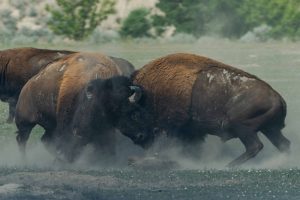
With such interruptions, a new hierarchy took over. Then, after things settled down again, each individual quietly accepted the new rankings.
Indeed, as Lott attests, such buffalo herd relationships are “too marvelous a tale to go untold.”
_______________________________________________________________________
Coming next: Saving the Buffalo from Extinction.”
_______________________________________________________________________
.
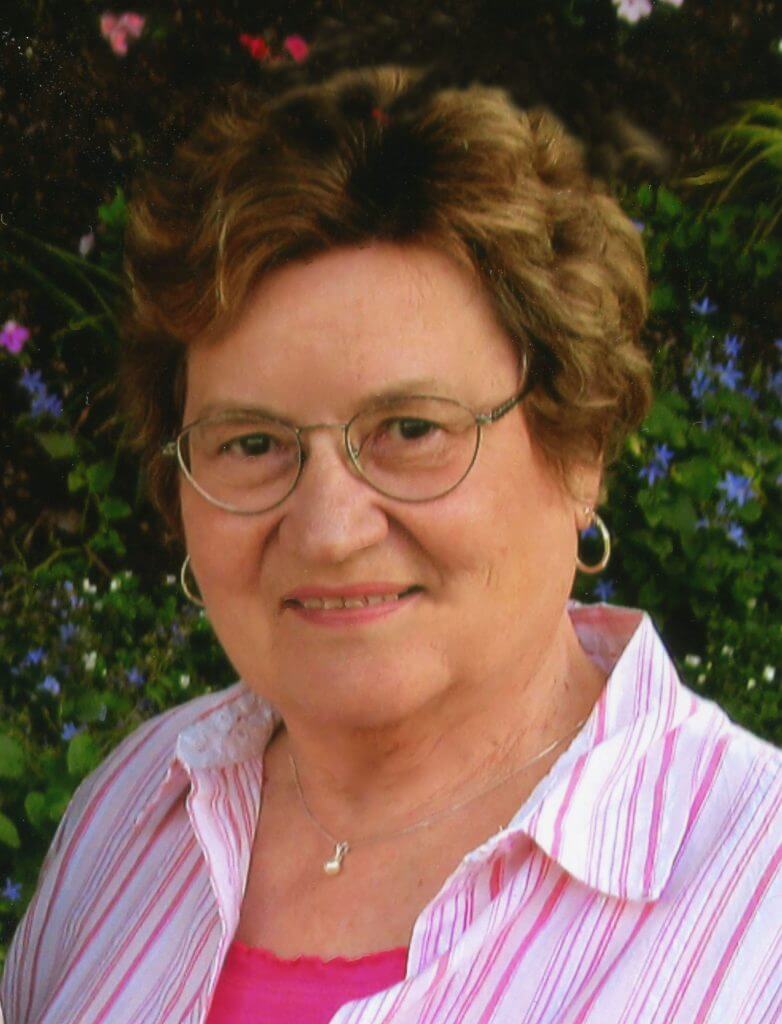
Francie M Berg
Author of the Buffalo Tales &Trails blog


